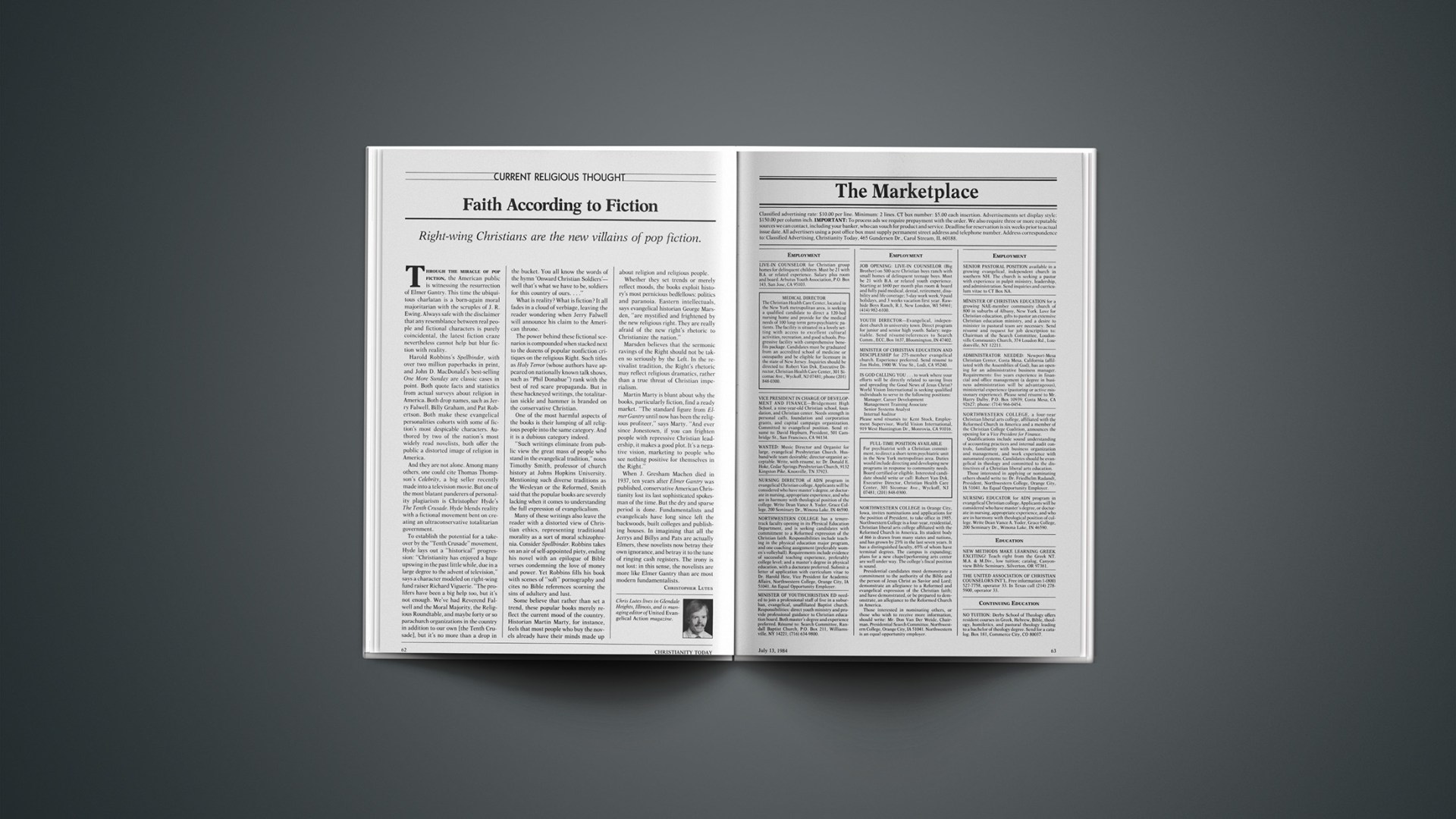Right-wing Christians are the new villains of pop fiction.
Through the miracle of pop fiction, the American public is witnessing the resurrection of Elmer Gantry. This time the ubiquitous charlatan is a born-again moral majoritarian with the scruples of J. R. Ewing. Always safe with the disclaimer that any resemblance between real people and fictional characters is purely coincidental, the latest fiction craze nevertheless cannot help but blur fiction with reality.
Harold Robbins’s Spellbinder, with over two million paperbacks in print, and John D. MacDonald’s best-selling One More Sunday are classic cases in point. Both quote facts and statistics from actual surveys about religion in America. Both drop names, such as Jerry Falwell, Billy Graham, and Pat Robertson. Both make these evangelical personalities cohorts with some of fiction’s most despicable characters. Authored by two of the nation’s most widely read novelists, both offer the public a distorted image of religion in America.
And they are not alone. Among many others, one could cite Thomas Thompson’s Celebrity, a big seller recently made into a television movie. But one of the most blatant panderers of personality plagiarism is Christopher Hyde’s The Tenth Crusade. Hyde blends reality with a fictional movement bent on creating an ultraconservative totalitarian government.
To establish the potential for a takeover by the “Tenth Crusade” movement, Hyde lays out a “historical” progression: “Christianity has enjoyed a huge upswing in the past little while, due in a large degree to the advent of television,” says a character modeled on right-wing fund raiser Richard Viguerie. “The prolifers have been a big help too, but it’s not enough. We’ve had Reverend Falwell and the Moral Majority, the Religious Roundtable, and maybe forty or so parachurch organizations in the country in addition to our own [the Tenth Crusade], but it’s no more than a drop in the bucket. You all know the words of the hymn ‘Onward Christian Soldiers’—well that’s what we have to be, soldiers for this country of ours.…”
What is reality? What is fiction? It all fades in a cloud of verbiage, leaving the reader wondering when Jerry Falwell will announce his claim to the American throne.
The power behind these fictional scenarios is compounded when stacked next to the dozens of popular nonfiction critiques on the religious Right. Such titles as Holy Terror (whose authors have appeared on nationally known talk shows, such as “Phil Donahue”) rank with the best of red scare propaganda. But in these hackneyed writings, the totalitarian sickle and hammer is branded on the conservative Christian.
One of the most harmful aspects of the books is their lumping of all religious people into the same category. And it is a dubious category indeed.
“Such writings eliminate from public view the great mass of people who stand in the evangelical tradition,” notes Timothy Smith, professor of church history at Johns Hopkins University. Mentioning such diverse traditions as the Wesleyan or the Reformed, Smith said that the popular books are severely lacking when it comes to understanding the full expression of evangelicalism.
Many of these writings also leave the reader with a distorted view of Christian ethics, representing traditional morality as a sort of moral schizophrenia. Consider Spellbinder. Robbins takes on an air of self-appointed piety, ending his novel with an epilogue of Bible verses condemning the love of money and power. Yet Robbins fills his book with scenes of “soft” pornography and cites no Bible references scorning the sins of adultery and lust.
Some believe that rather than set a trend, these popular books merely reflect the current mood of the country. Historian Martin Marty, for instance, feels that most people who buy the novels already have their minds made up about religion and religious people.
Whether they set trends or merely reflect moods, the books exploit history’s most pernicious bedfellows: politics and paranoia. Eastern intellectuals, says evangelical historian George Marsden, “are mystified and frightened by the new religious right. They are really afraid of the new right’s rhetoric to Christianize the nation.”
Marsden believes that the sermonic ravings of the Right should not be taken so seriously by the Left. In the revivalist tradition, the Right’s rhetoric may reflect religious dramatics, rather than a true threat of Christian imperialism.
Martin Marty is blunt about why the books, particularly fiction, find a ready market. “The standard figure from Elmer Gantry until now has been the religious profiteer,” says Marty. “And ever since Jonestown, if you can frighten people with repressive Christian leadership, it makes a good plot. It’s a negative vision, marketing to people who see nothing positive for themselves in the Right.”
When J. Gresham Machen died in 1937, ten years after Elmer Gantry was published, conservative American Christianity lost its last sophisticated spokesman of the time. But the dry and sparse period is done. Fundamentalists and evangelicals have long since left the backwoods, built colleges and publishing houses. In imagining that all the Jerrys and Billys and Pats are actually Elmers, these novelists now betray their own ignorance, and betray it to the tune of ringing cash registers. The irony is not lost: in this sense, the novelists are more like Elmer Gantry than are most modern fundamentalists.
Chris Lutes lives in Glendale Heights, Illinois, and is managing editor of United Evangelical Action magazine.










